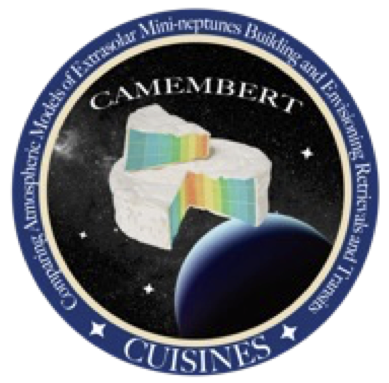CAMEMBERT: An Intercomparison of GCMs Modelling Mini-Neptunes.
With an increased focus on the observing and modelling of mini-Neptunes, there comes a need to better understand the tools we use to model their atmospheres. The CAMEMBERT (Comparing Atmospheric Models of Extrasolar Mini-neptunes Building and Envisioning Retrievals and Transits) project is an intercomparison of general circulation models (GCMs) used by the exoplanetary science community to simulate the atmospheres of mini-Neptunes. It focuses on two targets well studied both observationally and theoretically with planned JWST Cycle 1 observations: the warm GJ 1214b and the cooler K2-18b. For each target, the protocol considers a temperature-forced case, a clear sky dual-grey radiative transfer case, and a clear sky multi band radiative transfer case, covering a range of complexities and configurations where we know differences exist between GCMs in the literature. I serve as PI for the project, but involves significant contributions from a large number of members of the astrophysics community.
Website: https://nexss.info/cuisines/camembert-mip/
Protocol: arXiv:2211.04048
Cloud Formation in Hot Jupiter Atmospheres
With Drs. Nathan Mayne (at Exeter) and Stefan Lines (now at the Met Office), I have been investigating the formation of clouds in hot Jupiter atmospheres. Clouds, when present in the atmosphere, scatter and absorb light from the host star and thermal radiation from the planet below. This alters the atmospheric heating, changing the structure of the atmosphere. For this reason, self-consistent radiative feedback including clouds is important in modeling atmospheres.
The exoclimatology group at the University of Exeter has been using the UK Met Office’s Unified Model — the global climate model which they use to model the Earth — to model a host of exoplanets, from Earth-like terrestrial planets to hot Jupiters.
I am currently investigating how cloud formation prescriptions influence the atmospheric properties of hot Jupiters, and how the varying assumptions may influence observational results.
Recent Papers:
Christie et al. “The Impact of Phase Equilibrium Cloud Models on GCM simulations of GJ 1214b” 2022 MNRAS
Simulated collision between two giant molecular clouds with an initial magnetic field of 10 microGauss.
Collisions Between Giant Molecular Clouds
Collisions between giant molecular clouds (GMCs) provide a mechanism to both accelerate star formation and bring together the mass needed for massive star formation. With Drs. Jonathan Tan and Benjamin Wu, I have been investigating the role of magnetic fields in this process.
Because gas in the interstellar medium is partially ionized, it tends to move in tandem with the magnetic field. Collisions between GMCs tend to compress the magnetic field lines, a process which is resisted by the magnetic field, resulting in collapse being inhibited.
Recent Papers:
“GMC Collisions As Triggers of Star Formation. IV. The Role of Ambipolar Diffusion.” Christie, Wu, and Tan.
“GMC Collisions as Triggers of Star Formation. VII. The Effect of Magnetic Field Strength on Star Formation.” Wu, Tan, Christie, and Naramura.
H-alpha transit for HD189733b
H-alpha Absorption during Hot Jupiter Transits
Due to the intense EUV and FUV hot Jupiters experience due to their proximity to their host stars, they are expected to have outflows of gas driven from the planet. The primary constituent of these outflows — atomic hydrogen — can be difficult to detect in transit due to the interstellar medium obscuring much of the Lyman-alpha line.
Another option is to look for H-alpha absorption in transit (i.e., absorption and scattering by excited hydrogen atoms). While the abundance of excited hydrogen is small, the line does not suffer from obscuration by the the ISM. Using one-dimensional hydrostatic models, we have modeled the excited states of hydrogen within the atmosphere of HD189733b as well as generated synthetic transits which agree well with observations.
Work done in collaboration with Dr. Chenliang Huang as a part of his thesis has shown that the transit signal depends strongly on the Lyman-alpha radiation, both from the host star and in-situ sources such as radiative recombination.
Christie et al. “Hα Absorption by Hot Jupiter Atmospheres.” ApJ 2013
Huang et al. “A Model of the Hα and Na Transmission Spectrum of HD 189733b” ApJ 2017
The Parker Instability and the Formation of GMCs
The formation of cold atomic and molecular clouds in the galaxy is the result of phase transitions caused by a thermal instability; however, the observed physical properties of these clouds (masses, densities, magnetic- field strengths, temperatures, etc.) cannot be explained by the thermal instability alone. In the absence of a method for accumulating gas, the thermal instability creates cloudlets on the parsec scale or smaller with minuscule masses, nothing resembling the most massive giant molecular cloud complexes. Multiple mechanisms exist to accumulate gas (e.g., cloud-cloud collisions, Tasker and Tan 2009), and these mechanisms can operate in isolation or in concert; however, to form the largest cloud complexes, the accumulation of gas over hundreds of parsecs is required. The Parker instability naturally creates flows on these scales by creating large magnetic arches hundreds of parsecs in length. Gas flows down these arches and accumulates in the valleys, where cloud complexes can form. As a graduate student, I worked in collaboration with Telemachos Mouschovias and Matthew Kunz on a simulation of the nonlinear evolution of the Parker instability (Mouschovias, Kunz, and Christie 2009) as a mechanism for generating large clouds of atomic hydrogen. We found excellent agreement between the mass-to-magnetic flux ratios, velocity dispersions, masses, and sizes of the simulated clouds and those of observed clouds.
Mouschovias et al. “Formation of interstellar clouds: Parker instability with phase transitions” MNRAS 2009


